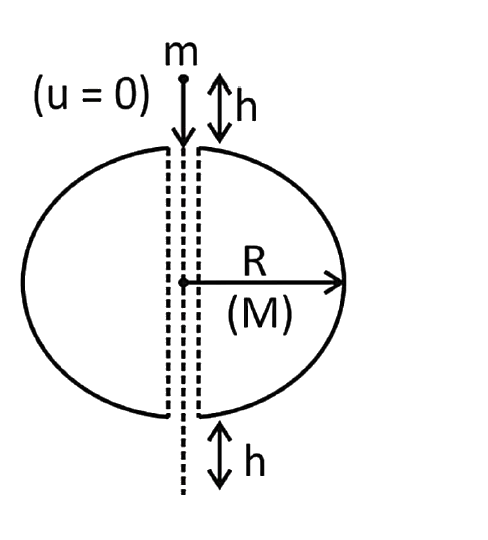An iron nail of mass m is dropped from a height h from level of a sand bed. If it penetrates through a distance x in the sand before coming to rest. Calculate the average force exerted by the sand on the nail. (Take g=10m/s2)
mg(hx+1)
mg(xh+1)
mg(hx−1)
mg(xh−1)
The correct Answer is:A
To solve the problem, we will use the work-energy theorem, which states that the work done by all forces acting on an object is equal to the change in its kinetic energy.
1. Identify the Forces Acting on the Nail:
- The gravitational force acting downwards: Fg=mg
- The drag force exerted by the sand acting upwards: Fd
2. Determine the Work Done by Gravity:
- The nail falls a total distance of h+x (where h is the height from which it was dropped and x is the distance it penetrates into the sand).
- The work done by gravity (which acts downwards) is given by:
Wg=Fg⋅d=mg(h+x)
3. Determine the Work Done by the Drag Force:
- The drag force acts upwards while the nail penetrates a distance x.
- The work done by the drag force is:
Wd=−Fd⋅x
- The negative sign indicates that the drag force is acting in the opposite direction to the displacement.
4. Apply the Work-Energy Theorem:
- According to the work-energy theorem:
Wg+Wd=ΔKE
- Since the nail starts from rest and comes to rest, the change in kinetic energy (ΔKE) is zero:
mg(h+x)−Fd⋅x=0
5. Solve for the Drag Force Fd:
- Rearranging the equation gives:
Fd⋅x=mg(h+x)
- Thus, we can express the drag force as:
Fd=mg(h+x)x
6. Simplify the Expression:
- This can be simplified to:
Fd=mg(1+hx)
Final Answer:
The average force exerted by the sand on the nail is:
Fd=mg(1+hx)
- The gravitational force acting downwards: Fg=mg
- The drag force exerted by the sand acting upwards: Fd
- The nail falls a total distance of h+x (where h is the height from which it was dropped and x is the distance it penetrates into the sand).
- The work done by gravity (which acts downwards) is given by:
Wg=Fg⋅d=mg(h+x)
- The drag force acts upwards while the nail penetrates a distance x.
- The work done by the drag force is:
Wd=−Fd⋅x
- The negative sign indicates that the drag force is acting in the opposite direction to the displacement.
- According to the work-energy theorem:
Wg+Wd=ΔKE
- Since the nail starts from rest and comes to rest, the change in kinetic energy (ΔKE) is zero:
mg(h+x)−Fd⋅x=0
- Rearranging the equation gives:
Fd⋅x=mg(h+x)
- Thus, we can express the drag force as:
Fd=mg(h+x)x
- This can be simplified to:
Fd=mg(1+hx)
The average force exerted by the sand on the nail is:
Fd=mg(1+hx)
Similar Questions
An open knife edge of mass 200g is dropped from height 5m on a cardboar. If the knife edge penetrates a distance 2 m into the cardboard. Find the average resistance offered by the cardboar to the knife edge (in N). (g=10m/s2)

View SolutionA ball is dropped from a height of 5 m onto a sandy floor and penetrates the sand up to 10 cm before coming to rest. Find the retardation of the ball in and assuming it to be uniform.
View Solution
Knowledge Check
An open knife edge of mass M is dropped from a height h on a wooden floor. If the blade penetrates S into the wood, the average resistance offered by the wood to the blade is
AM gBM g (1+hs)CM g (1−hS)DM g (1+hS)2
A body of mass 0.02 kg falls from a height of 5 metre into a pile of sand. The body penetrates the sand a distance of 5 cm before stoping. What force has the sand exerted on the body ?
View SolutionAn open knife of mass m is dropped from a height h on a wooden floor. If the blade penetrates up to the depth d into the wood. The average resistance offered by the wood to the knife edge is .
View SolutionA block of 200 g mass is dropped from a height of 2 m on to a spring and compress the spring to a distance of 50 cm. The force constant of the spring is
View SolutionA ball of mass m is dropped from a height h in a tunnel, made across the earth (mass = M, radius = R) passing through its center. If h<<R such that the motion of the particle through h can be considered uniformly accelerated at g, then the time period of the particle is

View SolutionA ball of mass m is dropped onto a floor from a certain height. The collision is perfectly elastic and the ball rebounds to the same height and again falls. Find the average force exerted by the ball on the floor during a long time interval.
View SolutionA ball is dropped from height 10 m . Ball is embedded in sand 1 m and stops, then
View SolutionA ball of mass 50 gm is dropped from a height h=10m. It rebounds losing 75 percent of its kinetic energy. If it remains in contanct with the ground for Δt=0.01 sec. the impulse of the impact force is (take g=10m/s2)
View Solution
